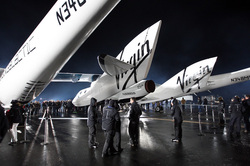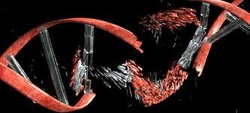 On Monday, US Customs officials handed over to China 100-million-year-old fossils which were smuggled into the US. The fossils include a partial dinosaur skull, several dinosaur eggs and a sabre-toothed cat’s bones.
According to the Homeland Security Department, the relics, which were undocumented and transported in two loads, were seized by custom agents stationed in Richmond and Chicago.
The department announced that they found the fossils during one of their routine inspections on incoming cargoes. Some cargoes were suspected to have been smuggled.
Assistant Secretary John Morton of Homeland Security said, "The attempt to remove them from China ran up against a network of national and international customs laws that are in place to protect against the theft of cultural property. We are pleased to return them to their rightful owners, the people of China.”
The Field Museum experts in Chicago noted that the confiscated dinosaur fossils date back to 100 million years. The fossils belong to a Psittacosaurus lujiatunesis, a two-legged dinosaur with a height of two meters and a skull with distinctive features, such as high nostrils and a parrot-like beak.
The smuggled fossils were returned to the Chinese Embassy in Washington. Deputy Chief of Mission Xie Feng expressed his gratitude towards the US government. He said, "In recent years, China and the US have developed close cooperation in law enforcement and made steady progress and prominent achievements, particularly in the fields as counterterrorism, drug enforcement as well as combating other transnational crimes.”
Chinese officials are on their way to the US to escort the prehistoric relics back to China.
 On Tuesday, Verizon Wireless expanded its service line with the introduction of the Samsung Rogue.
Though the Rogue doesn’t have all the features of a smartphone, it is reasonably priced and is capable of Internet browsing. The phone will be sold on a monthly plan.
The Rogue phone is fitted with a QWERTY keyboard on a slide-out panel, a high-speed EVDO Rev A data connectivity, and a quality Internet browser application. Instead of utilising the phone in a manner similar to the Android or Windows Mobile, Verizon designed the phone so that it could also be used as a data device. The Samsung Rogue is available for $99.99 for a service contract of two years. The Rogue is the pioneer of what is deemed as a new category in devices, which will have similar characteristics with the Rogue. Verizon aptly calls it, ‘Enhanced Multimedia Phones”.
The main feature of the phone is its browsing capabilities, and Verizon predicts that most of its consumers will use the phone because of this feature. The company charges $9.99 per month for browsing.
Though Rogue does not belong to the smartphone category, where devices like the iPhone and BlackBerry are the current leaders, it also comes with a monthly data plan. This scheme is new for Verizon, who usually charges customers with non-smartphones $1.99 per megabyte used.
According to mobile analysts, Verizon’s decision is a sign that the company seeks to maximise profits and revenues. Verizon has taken advantage of the consumers’ current interest in social networking, browsing through mobile data connectivity and downloading different applications.
 A spacecraft intended to fly well-off tourists into space by 2011 was made public on Monday, with hopes that it would mark the commencement of aviation history’s new era.
The SpaceShipTwo is the first ever commercial passenger spacecraft long awaited by many. The project is funded by Sir Richard Branson, a British billionaire who founded Virgin Galactic, working in partnership with Burt Rutan, a prominent aviation designer and also the brain behind this venture.
“We want this program to be a whole new beginning in a commercial era of space travel”, said Branson, who expects the flights to start by 2011.
The spacecraft was derived from a prototype known as SpaceShipOne, which has been designed by Rutan. It was in 2004 when SpaceShipOne bagged the Ansari X Prize worth $10 million as it was the first privately piloted spacecraft to have reached space.
According to the company building the craft, more or less 300 clients have already paid for a ticket worth $200,000 or have placed a deposit.
“NASA spent billions upon billions of dollars on space travel and has only managed to send 480 people,” said Branson. “We're literally hoping to send thousands of people into space over the next couple of years. We want to make sure that we build a spaceship that is 100 percent safe.”
SpaceShipTwo is created from lightweight complex materials, with a hybrid rocket motor to power it up. It measures about 60 feet long and can accommodate two pilots and six passengers.
Virgin Galactic estimates an expense of over $400 million for the construction of five more commercial spaceships in the future.
 The use of digital media is changing the way young people are learning today, said Mizuko ‘Mimi’ Ito of the University of California, Irvine.
A learning transformation has started in the US; however, it is not happening inside the schoolroom. Technology is revolutionising how young individuals learn, play and take part in the community, she says.
The researcher studies the utilisation of digital media, internet and other social networking sites in improving the way of learning for young people. The John D. & Catherine T. MacArthur Foundation granted a $2.97 million support for the study.
“Kids today are learning outside the boundaries of formal education,” states Ito. “Technology is allowing them to access information and craft their own identities in unprecedented ways, without interference from parents or teachers”.
She and other colleagues interviewed over 800 teens and observed them in social networking sites for more than three years. Their study serves as the basis for the new book, ‘Hanging Out, Messing Around, and Geeking Out: Kids Living and Learning with New Media’, which discusses the complex dynamics of the present generation under a digital era.
The study revealed that, in contrast with what adults perceive, youths develop significant life skills through the internet and gadgets, such as cell phones and iPods to play, socialise or research. They are able to cope with different norms, discover interests, practise technical abilities, and explore ways of self-expression. Teens have also welcomed the digital era, because it promotes self-directed knowledge and independence.
 The most important protein for copying DNA also plays an essential role in mending damages, scientists from UC Davis have found. The research is helping scientists understand the formation of cancer cells and their resistance to chemotherapy and radiation.
The protein, called the proliferating cell nuclear antigen (PCNA), develops into a hoop that fits around the double helix of the DNA. This hoop helps keep in position the DNA polymerase, the enzyme which generates a copy of the DNA strand after cells split into a pair of new cells.
The study reveals that PCNA plays a similar role in DNA recombination – when chromosome pairs line up and switch DNA strands. Recombination happens when cells separate to form sperms or eggs, as well as when cells attempt to fix breaks across the two DNA strands.
“This is a new trick from an old horse”, stated Wolf-Dietrich Heyer, a microbiology professor at UC Davis and head of the molecular oncology programme at the UC Davis Cancer Centre.
The system that was developed for the experiment, using purified proteins and distinct DNA substrates, may also be used to study the behaviour of molecules involved in the copying and repairing of DNA, he said.
Heyer’s laboratory works mainly with yeast. He noted that while yeasts do not have cancer, their DNA system for recombination and repair is basically similar to that of humans.
Cancer drugs and radiation therapy both result in breaks in the DNA of cancer cells. If enough breaks are created, the cancer cell dies. However, the repair mechanism of the cell seals and patches the gaps.
 The gases that formed Earth’s atmosphere, and possibly its oceans, did not originate from within the planet but from outer space, suggests a research by scientists from the University of Houston and University of Manchester.
The study, published in the journal Science, indicates that previous images of Earth having gigantic volcanoes emitting different gases into the atmosphere will need to be reconsidered.
According to the researchers, the long-standing belief that the planet’s earliest atmosphere came from volcanoes must be disregarded.
With the use of advanced analytical techniques, Dr Martin Cassidy, Professor Chris Ballentine and Dr Greg Holland examined volcanic gases to discover new evidence.
The study was financed by the Natural Environment Research Council (NERC).
“We found a clear meteorite signature in volcanic gases”, stated Dr Greg Holland, head scientist of the project.
"From that we now know that the volcanic gases could not have contributed in any significant way to the Earth's atmosphere. Therefore the atmosphere and oceans must have come from somewhere else, possibly from a late bombardment of gas and water rich materials similar to comets”.
“Until now, no one has had instruments capable of looking for these subtle signatures in samples from inside the Earth -- but now we can do exactly that”, he added.
The techniques they used allowed the researchers to measure small amounts of inert volcanic trace gases Xenon and Krypton, which showed an isotopic ‘fingerprint’ similar to that of meteorites.
The research is the first to describe the exact composition of Krypton found in the mantle of the Earth.
 Scientists from Duke University have discovered how the lotus stays dry despite growing in muddy, watery environments–a puzzle that has haunted scientists for a long time.
The scientists used an audio speaker, a powerful microscope and an ultra high-speed camera to unlock this ancient mystery. It was the first time the condensation of water on a lotus leaf’s surface and how the leaf sheds the water condensate have been observed.
The lotus leaves have tiny irregular lumps covered with even tinier protruding hairs. When water droplets land on this type of surface, they stay only at the ends of the hairs. The air pockets below then buoy the droplets off the leaf, keeping the leaf dry.
Jonathan Boreyko, a graduate student at the Pratt School of Engineering in Duke, said, “We faced a tricky problem – water droplets that fall on the leaf easily roll off, while condensate that grows from within the leaf's nooks and crannies is sticky and remains trapped”.
He added, "Scientists and engineers have long wondered how these sticky drops are eventually repelled from the leaf after their impalement onto the tiny projections. After bringing lotus leaves into the lab and watching the condensation as it formed, we were able to see how the sticky drops became ‘unsticky’”.
This biological mechanism of keeping dry has inspired the engineers working on the project to utilise man-made surfaces that resemble those of the lotus to enhance the efficiency of today’s engineering systems. The mechanism can be applied to electronic equipment or power plants that need cooling through the removal of heat by water evaporation and condensation.
 The Physical Research Laboratory (PRL) and Space Application Centre (SAC), ISRO in Ahmadabad did not have a successful moon mission; radio contact with the Chandrayann-1 satellite was lost last Saturday.
However, the scientists involved in the mission are not giving up hope of gaining useful data that they were able to gather through Chandrayaan-1 before the mission was suddenly terminated.
The deputy director of SAC, ISRO, Kiran Kumar, is still hoping that the mission will be revived in the future. According to him, "It is a great loss but the entire Chandrayaan-1 team is watching for any chance to retain the mission. We will be meeting principal investigators of the instruments aboard Chandrayaan-1 in the first week of September. The team was hopeful that the mission would cover its two-year period."
Also, according to Kumar, while the mission is terminated, the data collected through the satellite will be analysed.
Chandrayaan-1 is orbiting the moon to survey its surface and take high-resolution images of it. The mission aims to make a map of the moon’s three-dimensional topography and chemical features.
One of the members of the science advisory board for Chandrayaan-1, Professor Narenda Bhandari, said, "It is difficult to ascertain reasons for loss of contact. We have excelled in departments like propulsion system, reaching the moon in a precise manner. However, the thermal profiling and the sun sensors on the satellite did not give the expected result."
Professor Bhandari studies the moon’s chemical composition on its surface.
"The most important thing for us now is to ascertain answers from the collected data," Bhandari added.
 Harvard University researchers have discovered a way to bend straight nanowires into zigzagging two-dimensional and three-dimensional structures that have correspondingly advanced functions.
Charles M. Lieber and Bozhi Tian led the team whose work was published this week in the Nature Nanotechnology journal.
The authors said that one possible application of this new technology is that it could lead to a new approach for detecting the electrical currents in tissues and cells.
Lieber said, "We are very excited about the prospects this research opens up for nanotechnology. For example, our nanostructures make possible integration of active devices in nanoelectronic and photonic circuits, as well as totally new approaches for extra- and intracellular biological sensors. This latter area is one where we already have exciting new results and one we believe can change the way much electrical recording in biology and medicine is carried out".
The scientists carefully introduced triangular “stereocenters,” or fixed 120-degree joints, into the previously rigidly linear nanowires. These stereocenters are similar to chemical hubs present in a number of complex organic molecules. The hubs transform one-dimensional nanostructures into complex forms by introducing kinks, just like the stereocenters.
Tian and Lieber’s team managed to introduce the stereocenters while the nanowires self-assembled. The team removed important gaseous reactants contained in the chemical brew where the self-assembly was occurring, therefore halting the 1-D nanostructures’ growth for 15 seconds. They reintroduced the reactants after the joints had been formed. The technique resulted in a bent nanowire yield of 40 percent, which could later be purified for higher yields.
|









 RSS Feed
RSS Feed